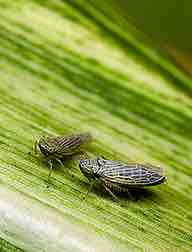A DNA virus is a virus with DNA as its genetic material and replicates using a DNA-dependent DNA polymerase. DNA viruses belong to either Group I (double-stranded DNA; dsDNA) or Group II (single-stranded DNA; ssDNA) of the Baltimore classification system for viruses. Single-stranded DNA is usually expanded to double-stranded in infected cells.
DNA viruses are relatively rare in plants. Seventeen percent of plant viruses are ssDNA, while dsDNA viruses infect only lower plants, such as eukaryotic algae. The rarity of dsDNA plant viruses is notable when compared to other taxonomic kingdoms; a quarter of animal viruses and three quarters of bacterial viruses are dsDNA.
Plant viruses are transmitted through a variety of different methods, and generally require breach of protective barriers. Viruses can be spread by direct transfer of sap by contact of a wounded plant with a healthy one, most commonly resulting from agricultural practices, as by damage caused by tools or hands. More often, viruses are spread through vector intermediaries such as insects, nematodes, or protozoa which pick up viruses by feeding on infected plants, and then spread the virus to healthy plants.
Viral transmission from generation to generation occurs in about 20% of plant viruses. When viruses are transmitted by seeds, the seed is infected in the generative cells and the virus is maintained in the germ cells, or occasionally in the seed coat. Little is known about the mechanisms involved in the transmission of plant viruses via seeds, though environment is known to play a key role.
Single-Stranded DNA Viruses
The Geminiviridae and Nanoviridae are the two families of ssDNA viruses known to infect plants. Geminiviridae is the largest known family of single-stranded DNA viruses. It contains a wide range of plant viruses including bean golden mosaic virus, beet curly top virus, maize streak virus , and tomato pseudo-curly top virus, which together are responsible for a significant amount of crop damage worldwide. The genome can either be a single component between 2500-3100 nucleotides, or, in the case of some begomoviruses, two similar-sized components each between 2600 and 2800 nucleotides. They have elongated, geminate capsids with two incomplete T=1 icosahedra joined at the missing vertex . The capsids range in size from 18-20 nm in diameter with a length of about 30 nm. Begomoviruses possess two component genomes separated into two different particles, both of which must usually be transmitted together to initiate a new infection within a suitable host cell. Like many viruses, geminivirus genomes encode only a few proteins, and are therefore dependent on host cell factors for replication. Geminiviruses replication occurs within the nucleus of an infected plant cell via a rolling circle mechanism, similar to that seen in bacteriophages, such as M13, and many plasmids. The resulting ssDNA is packaged into germinate particles in the nucleus. It is not clear if these particles can then leave the nucleus and be transmitted to surrounding cells as virions, or whether ssDNA is trafficked from cell to cell via the plasmodesmata. These viruses tend to be introduced into and initially infect differentiated plant cells, via the piercing mouthparts of the vector insect: however, these cells generally lack the host enzymes necessary for DNA replication, making it difficult for the virus to replicate. To overcome this block geminiviruses can induce plant cells to reenter the cell cycle from a quiescent state so that viral replication can occur.

Geminiviruses
Drawing of geminiviruses, characterized by elongated, geminate capsids with two incomplete T=1 icosahedra joined at the missing vertex.
The Nanoviridae are a family of single-stranded DNA viruses that infect plants. Their name is derived from the Greek word 'nano' (dwarf) because of their small genome and their stunting effect on infected plants.
Virions of this family have a capsid and are non-enveloped. The capsid is icosahedral with diameter of 18-20 nm. The genome is composed of 6 to 11 segments of single-stranded circular DNA each ~1 kb in length, with the exact number of segments varying depending on the genus. The segments each encode a single protein. There is a putative stem loop structure in the non-coding region of each segment which has a conserved 9-nucleotide sequence at its apex. Each member has up to 4 segments encoding replication proteins of ~33 kDa. The other segments encode products of 10-20 kDa in size and include a coat protein of ~19 kDa and a protein with a retinoblastoma binding motif.
Double-Stranded DNA Viruses
Double-stranded DNA viruses of plants are rare, and only infect lower plants, such as algae. These viruses (family Phycodnaviridae) are huge dsDNA viruses with genomes ranging from 160 to 560 kb with up to 600 protein-encoding genes, making them distinctly different from viruses infecting higher plants. They are found in aqueous environments throughout the world and play dynamic, albeit largely undocumented, roles in regulating algal communities such as the termination of massive algal blooms commonly referred to as red and brown tides.

Maize Streak Virus
The black-faced leafhopper (Graminella nigrifrons) transmits both maize fine streak virus and maize chlorotic dwarf virus.